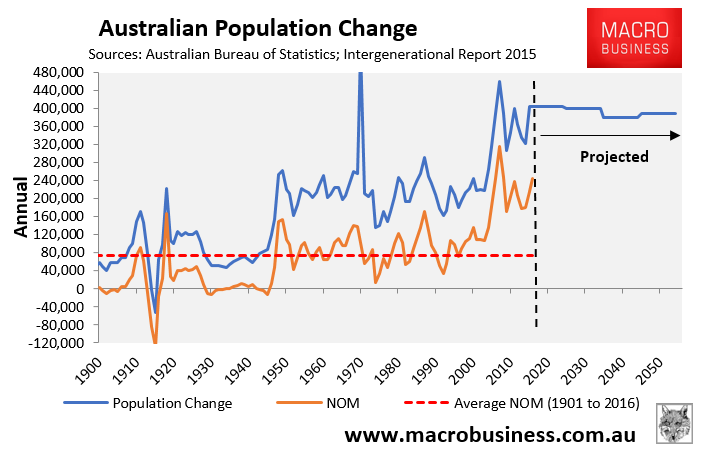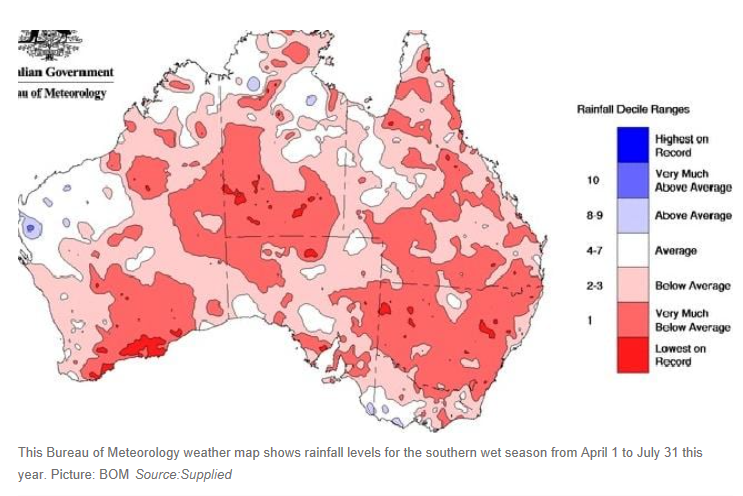Back in February, Dr Jonathan Sobels – a senior research fellow at the University of South Australia and the author of a key 2010 report prepared for the Department of Immigration entitled Long-term physical implications of net overseas migration: Australia in 2050 – gave a brilliant incisive interview on ABC’s Radio National that among other things warned that Australia’s water security is being placed at risk from endless mass immigration:
…we are coming up towards physical limitations within our physical, built and natural environments that will lead to compromises in the quality of our life…
Not only are the dams not filling, but the ground water supplies are not filling. The only option you have open to you is water efficiency use and whacking up desal plants. But if your population keeps increasing at the rates we have seen in recent times, you won’t be able to afford putting up billion dollar desal plants, which also have their environmental impacts…
In March, ABC News warned that Australia’s water supplies will be placed under intense pressure as the nation’s population balloons:
In Sydney, when Warragamba dam is full, the city has about four years worth of water supply.
Double the population, as is forecast in 50 years, and that falls to two years worth of water supply — and that is only when it is full, a scenario that might become a lot less frequent with climate change.
But that is what desalination plants are for, right? Well … only to a point.
In Sydney, most of the 725,000 new dwellings that will need to be built by 2036 to keep pace with population growth will be built in the west, according to the Greater Sydney Commission… the trend is the same for all coastal capital cities: population growth is moving away from the coast and away from desalination plants.
“Water being non-compressible and quite a heavy substance — it’s quite expensive to transport,” said Mr Lovell.
“Even if you’re looking at Sydney on the coast through to Penrith or from Wonthaggi to the north of Melbourne — you’re looking at 80 to 90 kilometres. That’s really expensive, and it’s a really inefficient way to transport water”…
Professor Khan said a whole new set of pipelines would need to be built to get desalinated water west of there, where the population growth will be.
“The further you (pump desalinated water) inland, the more you’re working in a direction that is opposite to the way our water supply systems are designed and operate,” he said.
“They pump water from the source — up in the reservoirs, up in the hills — to the coast. And it’s very difficult to actually turn that around.”
Of course, desalination plants are environmentally destructive and hideously expensive, with costs borne by the incumbent population, as noted by The Conversation:
The desalination plants were expensive to build, consume vast quantities of electricity and are very expensive to run. They remain costly to maintain, even if they do not supply desalinated water. All residents pay higher water rates as a result of their existence.
Indeed, in December, Infrastructure Australia reported that household water bills will double in line with energy bills because of population growth and climate change – hitting more than $2500 a year by 2040:
Modelling in the report forecasts that a typical residential water and sewerage bill “could rise by around $600 in today’s money over the next 10 years”. This would result in average bills increasing from $1226 to $1827 in 2027. By 2040, the modelling shows the average would reach as high as $2553. This would represent more than a doubling in real terms.
“For many families, growth in bills of this scale could cause significant hardship”…
The report says that a failure to factor in urban population growth, ageing infrastructure and climate change impacts on supply would expose consumers to price shock risks…
Now, NSW and parts of QLD are in the grips of a severe drought, which is decimating rural communities:
Farmers have said this drought is the worst they’ve faced financially.
Some have reported churning through $1 million in a year just trying to feed their livestock…
Properties are too dry to produce any feed of their own and livestock are so starving farmers have been forced to shoot thousands of animals to put them out of their misery.
Mr Alder, who started the hay charity in 2013, has been inundated with requests from desperate farmers across the country…
Their waiting list is 850 farmers long and Mr Alder said sadly if they delivered a trailer to someone one month, they would only be calling again a month later…
NSW has recorded the fifth-driest July on record with the dry spell marking the seventh consecutive month of below-average rainfall across the state.
The latest Bureau of Meteorology climate summary, released on Wednesday, found it was also the driest July since 2002 with many areas across the state recording the lowest July rainfall on record or the lowest amount for at least 20 years.
Queensland’s Department of Agriculture and Fisheries estimates 57 per cent of that state is in drought.
Sydney’s water catchments, too, are shrinking due to insufficient rainfall meeting rising demand:
Water levels at storages supplying the Sydney metropolitan area are sinking amid a lack of rain and rising consumption…
“All Sydney storage levels have fallen as water is used to provide for Sydney’s water supply, while record low rainfall in catchment areas [has resulted] in minimal replenishing inflows,” a WaterNSW spokesman said.
“The absence of significant rainfall forecast and the extremely dry catchments means, unfortunately, there is little prospect of respite statewide in the short term”…
July was Sydney’s driest since 1995… The extended dry spell for much of Sydney – and the rest of the state – has triggered a rise in water consumption…
Gary Hurley, Sydney Water’s manager for networks, said the drying conditions had led to a spike in leaks and breaks in water pipes…
Water deficiencies are spreading across eastern Australia, especially in NSW.
Water scarcity is the elephant in the room of the population debate, and an issue that Australia’s mass immigration ‘Big Australia’ boosters conveniently ignore.
In addition to the exorbitant costs of securing our cities’ water supplies as their populations balloon, the regular droughts occurring across regional Australia makes the smokescreen of ‘decentralisation’ and shifting migrants to the regions a pipe dream – there simply isn’t enough water to sustain large regional populations.
There is, of course, an cheap and easy solution to ameliorating water pressures – one that requires minimal additional investment, nor expensive technical solutions like desalination of recycling of effluent: cutting immigration back to historical levels:

As noted in the 2010 report prepared for the Department of Immigration, entitled Long-term physical implications of net overseas migration: Australia in 2050:
Decreased urban water supply is a significant environmental constraint exacerbated by higher levels of NOM. Modelling shows the vulnerability of Sydney, Melbourne, Brisbane and Perth to deficits in water supply, on a NOM strategy of 260,000 pa.: a view strongly supported by empirical review of State Government reports…
Only NOM levels of 50,000 pa or less result in Melbourne and Sydney maintaining a small surplus of net surface supply over demand on average out to 2050, assuming current climate conditions persist. Potential options to alleviate water stress at high NOM levels over the longer term may be hard to find.
Former Treasury Secretary, Ken Henry, raised similar concerns in 2009:
“…with a population of 22 million people, we haven’t managed to find accommodation with our environment. Our record has been poor and in my view we are not well placed to deal effectively with the environmental challenges posed by a population of 35 million.”
Clearly, Australia’s mass immigration ‘Big Australia’ policy is a key threat to Australia’s water security. So why exacerbate the problem in the first place, when it can be ameliorated by simply returning Australia’s immigration intake back to the historical average of 70,000 people a year?
unconventionaleconomist@hotmail.com


